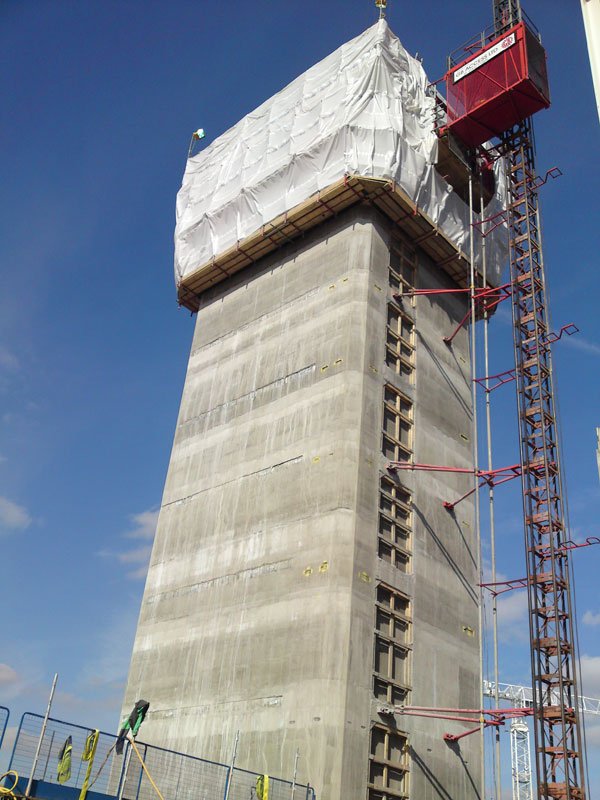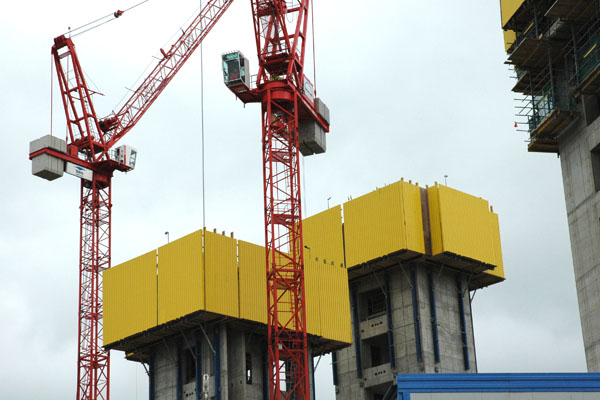Jump form or climbing formwork is used for large vertical concrete structures. Jump form systems comprise the formwork and working platforms for cleaning/fixing of the formwork, steel fixing and concreting. The formwork supports itself on the concrete cast earlier so does not rely on support or access from other parts of the building or permanent works. It can be an effective solution for buildings that are either very repetitive in form (such as towers or skyscrapers) or that require a seamless wall structure.
Advantages of Jump Form
- Faster construction
- Does not require a crane to move them, reducing your general condition cost.
- Increased construction speed is obtained by allowing the vertical and horizontal parts of a building to be built concurrently.
- The formwork is supported independently so that the sheer walls as well as core walls may be completed before the rest of the structure of the main building.
- Good quality surface finishes.
- The climbing forms may be designed for operating in the high winds.
- It’s very easy to plan the construction activities because of the repetitive nature of work.
- Engineered nature of jump form systems allows quick and precise adjustment of the formwork in all planes.
- Minimizes the usage of scaffolding and temp work platforms.
- Long lengths can be obtained combining different sections.
- Minimizes labor time and has a better productivity rate.
- Other protection systems (Screens) can be hung off a big Jump Form and climbed with the system.
- Long lengths can be obtained combining different sections for each particular project.
- Can be used at an inclined angle.
- The formwork system is easy to clean and reuse with little formwork waste generated compared to traditional formwork.
- Climbing formwork systems offer simplicity, safety and cost effectiveness for certain high-rise building structures.
- The repetitive nature of the work, combined with the engineered nature of the formwork, allows fine tuning of the construction operations, which in turn leads to minimal concrete wastage.
- Many repeated uses of formwork are possible before maintenance or replacement is needed, the number of uses depending on the quality of the surface finish of concrete specified.

Different types of Jump Form
- Normal jump or the climbing form – the units are lifted off individually off the structures and then relocated at the next level of construction with the help of a crane. The availability of the crane is crucial.
- Guided climbing jump form – it also uses the crane but it also offers greater level of safety and security as well as control while lifting the units which are anchored as well as guided by the structures.
- Self-climbing jump form – it doesn’t need a crane since it climbs on the rails up to the building with the help of hydraulic jacks.
- Gliding form – This type of formwork is similar to the self-climbing type above. However, the climbing process is continuous instead of intermittent, and is usually only interrupted for a very short time (for example to fix the mounting mechanisms to new anchoring points). The advantage is that it will produce seamless structures, but it requires a continuous, uninterrupted process throughout, with serious potential quality and stability problems if the pour has to be stopped.

Applications of Jump Form
Jumpform is suitable for construction of multi-storey, vertical concrete elements in high-rise structures, such as:
- Shear walls
- Core walls
- Lift shafts
- Stair shafts
- Bridge pylons

